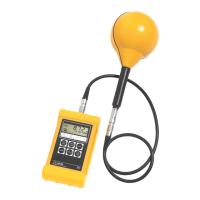
Do you have a question about the NARDA ELT-400 and is the answer not in the manual?
| Dynamic Range | 80 dB |
|---|---|
| Display | LCD |
| Isotropic Probe | Yes |
| Data Logging | Yes |
| Interface | USB |
| Weight | 1.2 kg |
| Power Supply | Rechargeable battery |
| Frequency Range | 1 Hz to 400 kHz |
Provides an overview of the ELT-400, its applications, and manual conventions.
Details the suitability of the ELT-400 for production areas, everyday environments, and EMC labs.
Explains typographical conventions and symbols used in the manual for clarity.
Instructions to ensure the instrument's condition and safe operation before initial use.
Covers safe operation, strong field risks, frequency limits, electrical hazards, malfunctions, and explosion risks.
Safety guidelines for the AC adapter/charger unit, including electric shock and destruction risks.
Procedures for handling instruments with damage or subjected to excessive stress.
Guides on unpacking, checking contents, handling transport damage, and recovery after storage.
Details on using rechargeable and alkaline batteries, including handling and charging procedures.
Steps for setting up the instrument and connecting the B field probe for measurements.
Overview of the instrument's keypad and the functions of each button.
Explains the various elements displayed on the LCD screen and their meanings.
Instructions on how to switch the display backlight on and off.
Description of the instrument's external connector sockets and their functions.
Overview of Exposure STD and Field Strength modes for measurements.
Guides on powering the instrument, selecting modes, setting parameters, and interpreting results.
Details on selecting operating mode, detection mode, frequency range, and measurement range.
Explains MAX HOLD function, interpreting results, and troubleshooting overload displays.
Details on using the analog output for advanced analysis with oscilloscopes or FFT analyzers.
Covers battery replacement, handling, and proper disposal procedures.
Instructions for cleaning the instrument and information on the AC adapter/charger unit.
Guides on connecting the instrument to a PC via data link and interface parameters.
Covers command overview, format conventions, and response value formats.
Details commands for probe, mode, parameter settings, data transfer, and status queries.
Includes commands for data transfer, battery status, overload status, and instrument identification.
Covers commands for locking the keypad and setting default instrument values.
Command for querying the error status resulting from the last command.
Explains the core principle of magnetic flux density measurement using coils and DSP.
Details frequency range, measurement range, damage level, and value collection for Field Strength mode.
Covers measurement uncertainty, influencing factors, and result display specifications.
Details frequency range, measurement range, and dynamic range for Exposure STD mode.
Includes display type, refresh rate, and remote control interface specifications.
Details analog output, probe characteristics, and power supply specifications.
Specs for AC adapter, calibration interval, and conformance labeling.
Covers climatic conditions, dimensions, and weight.
Information on ordering modes, order numbers, and package contents.
Lists optional accessories available for the ELT-400.
Lists the default values (ex-works settings) for various instrument parameters.
Shows how parameter statuses change after specific actions or remote control commands.
Explains the basis of field exposure measurement and the role of standards.
Details how exposure is calculated based on reference values and standards.
Explains frequency and field strength dependencies affecting limit values.
Highlights advantages of the Exposure STD method and comparison notes.
Explains the core principle of voltage evaluation for magnetic flux density measurement.
Illustrates the internal block circuit diagram of the instrument.
Defines the intended frequency response and differences between operating modes.
Explains simultaneous RMS and peak value measurement and calculation methods.
Details peak value calculation and explains results in Stnd (Standard) mode.
Shows graphs illustrating signal attenuation at upper and lower frequency limits.
Explains how the instrument handles field variations and display updates.
Describes how overload indicators are displayed and managed.
Information on the internal probe coil arrangement and spatial axis matching.
Detailed instructions on how to correctly position the probe for accurate measurements.
Details the connections for the analog interface cable using Koax and DB9 plugs.